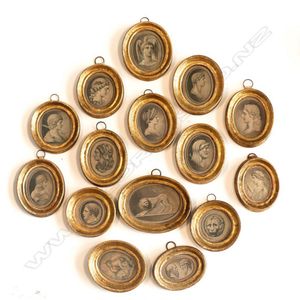Georgian Period Portrait Engravings with Gilt Frames
A collection of 15 miniature Georgian period classical portrait engravings, of various shapes and sizes with details on reverse, original gilt wood frames with suspension rings. Includes Medusa on Calcedon, L.d'Carlisle, Young Hercules, etc. Largest diameter 11.5 cm
You must be a subscriber, and be logged in to view price and dealer details.
Subscribe Now to view actual auction price for this item
When you subscribe, you have the option of setting the currency in which to display prices to $Au, $US, $NZ or Stg.
This item has been sold, and the description, image and price are for reference purposes only.
- Georgian - As an English stylistic period, Georgian is usually taken to cover the period from George I (1714) to the Regency of Prince George (1811-20), although the period from 1800 to 1830 is sometimes designated as the Regency period. During the Georgian period the great English cabinetmakers and designers such as Chippendale, Hepplewhite, Adam Sheraton etc., were all active.
Therefore there isn't a single 'Georgian style' as such and to say something is 'Georgian', usually means it was made between 1714 and 1830. This assumes we discount George V and George VI, both being from the 20th century.
The styles popular at the time of each reign were:
George I (1714-1727) saw out the last years of the Baroque period.
George II (1727-1760) reigned during the Rococo period.
George III (1760-1820) saw the last gasp of the Rococo, all of the early Neo-Classic 'Adam style' and most of the later neo-Classic 'Regency style'.
George IV (Prince Regent 1820-1830)encompassed the last of the 'Regency' style.
William IV's reign (1830-1837) was something of a no man's land (stylistically) and he wasn't a 'George' anyway. He covered the last glimmerings of 'Regency' and the start of the 'Victorian' style. - Giltwood - Giltwood is used to describe a gold finish on furniture and other decorative wooden items, whereby a thin sheet of gold metal, called gold leaf, is applied to the surface for decorative purposes.
Unlike gilding, where the gold leaf is applied over a coating of gesso, with giltwood the gold leaf is applied direct to the surface, or over a coat of linseed oil gold leaf adhesive.
Most gold-finished mirrors will be gilded, whereas furniture with gold highlights will have the gold applied through the giltwood method.
This item has been included into following indexes:
-
miniatures
- Georgian 230
- portrait and other 1,173
- sets or collections 146
Visually similar items

French Limoges porcelain tea service by Rene Claire, 24 place setting, 51 pieces in al
Sold by
in
for
You can display prices in $Au, $US, $NZ or Stg.

A group of Chinese kitchen Ceramics, each of bowl form, decorated in underglaze blue, 16th - 18th century (13)
Sold by
in
for
You can display prices in $Au, $US, $NZ or Stg.

An Australian opal brooch, of starburst design, set with opals cut en cabochon, in 15ct gold, boxed
Sold by
in
for
You can display prices in $Au, $US, $NZ or Stg.

A framed collection of thirteen Georgian miniature s of legal gentlemen, oval on ivory
Sold by
in
for
You can display prices in $Au, $US, $NZ or Stg.
